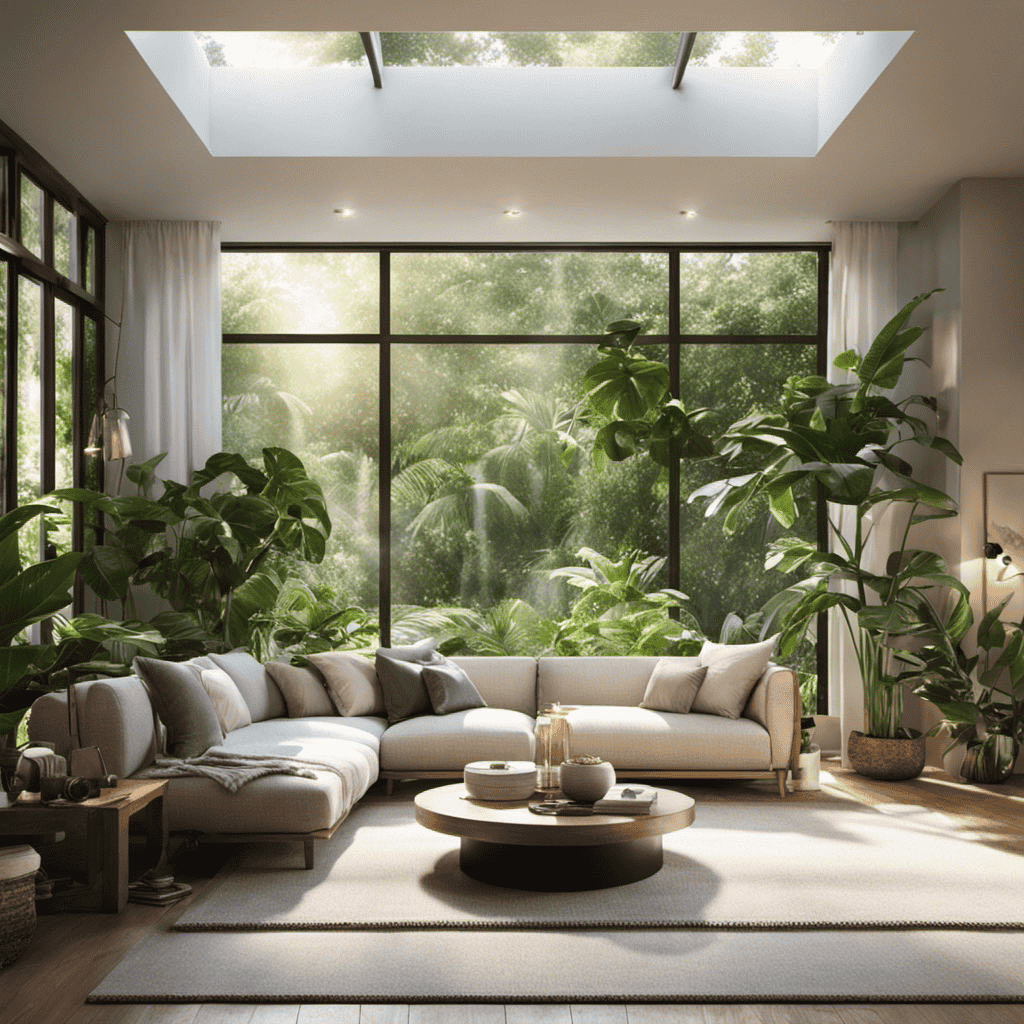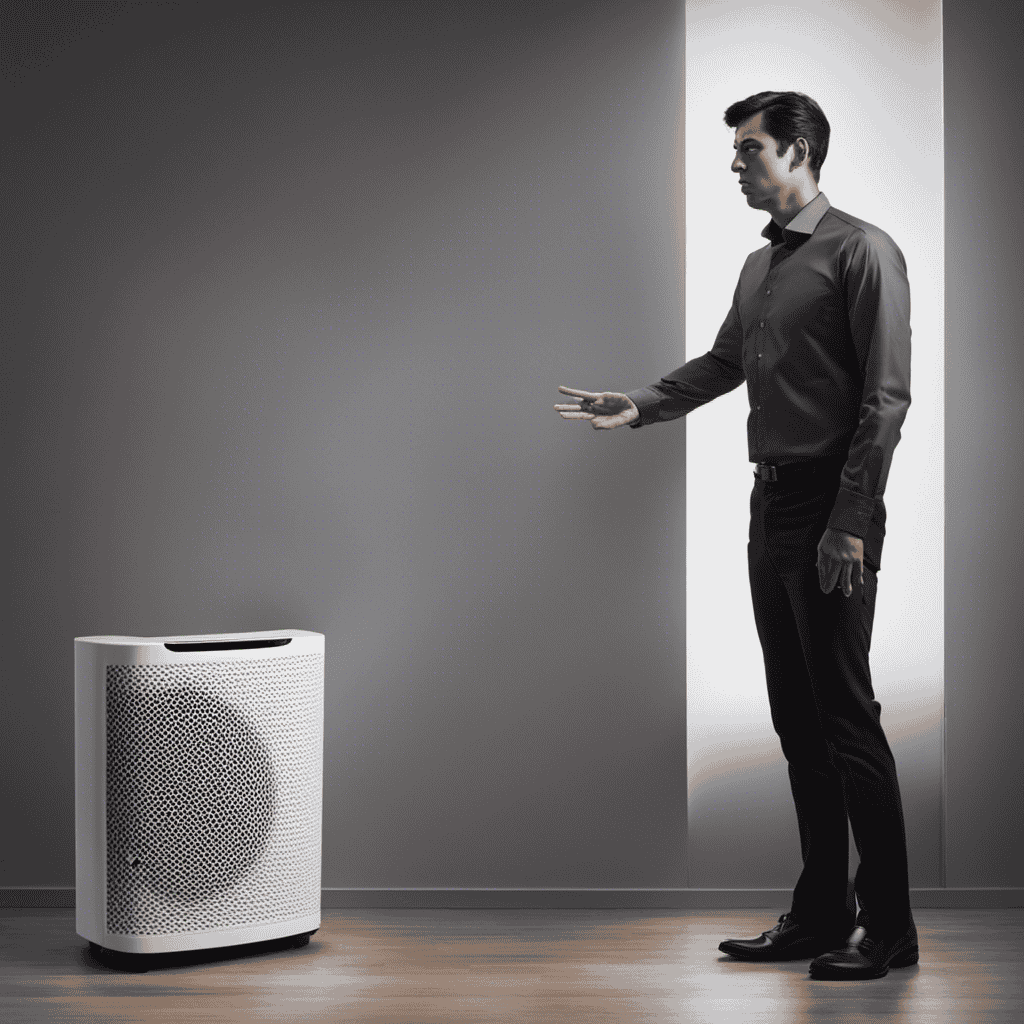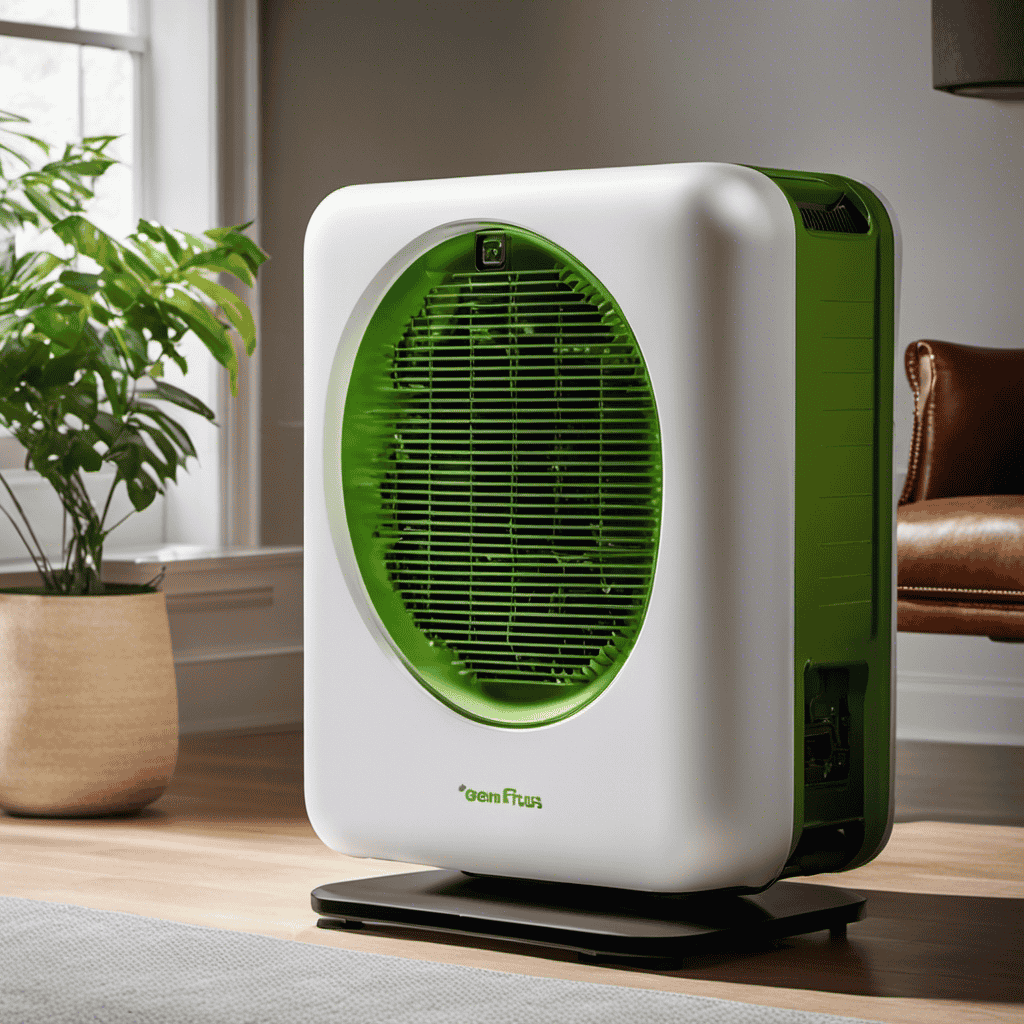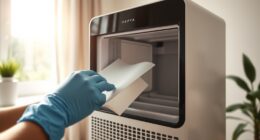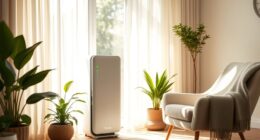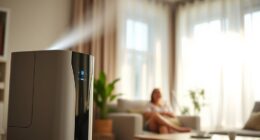Being concerned about the air quality in my home, I couldn’t help but question the need for an air purifier. However, after conducting thorough research, I came to realize the many advantages of owning one.
Air purifiers not only improve indoor air quality but also remove common pollutants like dust, pet dander, and allergens.
In this article, I will delve into the different types of air purifiers, how to choose the right size, and even explore the cost savings associated with using one.
So, let’s dive in and find out why investing in an air purifier is a smart choice.
Key Takeaways
- Improved indoor air quality
- Reduction of common pollutants like dust, pet dander, and allergens
- Relief for respiratory conditions
- Elimination of unpleasant odors
Benefits of Having an Air Purifier
Having an air purifier can greatly improve the air quality in your home, making it easier for you to breathe and reducing the risk of respiratory issues. Air purifiers have several benefits and health advantages that make them a worthwhile investment.
Firstly, they remove airborne pollutants such as dust, pollen, pet dander, and mold spores, which can trigger allergies and asthma attacks. This can provide relief for individuals with respiratory conditions and improve overall respiratory health.
Secondly, air purifiers can eliminate unpleasant odors and harmful chemicals present in the air, promoting a fresher and healthier living environment. Additionally, they can help to reduce the spread of airborne viruses and bacteria, enhancing your immune system’s defense against illnesses.
With these benefits in mind, it is clear that having an air purifier is essential for maintaining a healthy and comfortable indoor environment. In the subsequent section, we will explore in more detail how air purifiers effectively improve indoor air quality.
How Air Purifiers Improve Indoor Air Quality
Improving indoor air quality is one of the main benefits of using an air purifier. With advanced filter technology, air purifiers effectively remove pollutants and allergens from the air, creating a cleaner and healthier environment. Here are four reasons why air purifiers are essential for maintaining good indoor air quality:
-
Removes airborne particles: Air purifiers capture and trap particles like dust, pollen, pet dander, and mold spores, reducing the risk of respiratory issues.
-
Eliminates odors: Air purifiers with activated carbon filters absorb and neutralize unpleasant odors caused by cooking, pets, or smoke, leaving your home smelling fresh.
-
Reduces harmful gases: Some air purifiers are equipped with filters that can remove volatile organic compounds (VOCs) and other harmful gases, promoting a safer living space.
-
Enhances overall well-being: Clean air improves sleep quality, boosts productivity, and reduces allergies and asthma symptoms, leading to better overall health.
To ensure optimal performance, regular air purifier maintenance, such as replacing filters as recommended by the manufacturer, is crucial.
Common Air Pollutants Removed by Air Purifiers
Air purifiers effectively capture and remove common air pollutants, such as dust, pollen, pet dander, and mold spores. By eliminating these contaminants, air purifiers play a crucial role in preventing respiratory illnesses and reducing indoor allergens. According to studies, indoor air can be up to five times more polluted than outdoor air, making it essential to invest in a reliable air purifier.
To further highlight the importance of air purifiers, let’s take a look at the table below:
| Air Pollutants | Health Effects |
|---|---|
| Dust | Allergies, asthma, respiratory issues |
| Pollen | Allergies, hay fever |
| Pet Dander | Allergies, asthma, respiratory issues |
| Mold Spores | Allergies, asthma, respiratory issues |
As you can see, these common air pollutants can have detrimental effects on our health, especially for those with allergies or respiratory conditions. An air purifier acts as a powerful tool in improving indoor air quality, providing cleaner and healthier air for everyone.
Choosing the Right Size Air Purifier for Your Space
To ensure you select the correct size, consider the square footage of the space you want to purify. Choosing the right size air purifier is crucial for optimal performance and cost considerations.
Here are four key factors to keep in mind when estimating the room size:
-
Room dimensions: Measure the length and width of the room to determine the square footage. This will help you identify the appropriate air purifier size for effective purification.
-
Air changes per hour (ACH): Consider the level of air pollution in your space. Higher ACH values are recommended for rooms with higher pollutant levels or for individuals with allergies or respiratory issues.
-
Clean Air Delivery Rate (CADR): Look for air purifiers with a CADR that matches your room size. The CADR indicates the volume of clean air produced per minute and is typically provided for different particle sizes (e.g., pollen, dust, smoke).
-
Noise level: Consider the noise tolerance level for the room. Larger air purifiers tend to have higher fan speeds, which can result in more noise.
Understanding Different Types of Air Purifiers
When it comes to choosing an air purifier, it’s important to understand the differences in filter effectiveness, energy consumption, and noise levels.
Comparing the effectiveness of filters will help determine the level of air purification you can expect.
Considering energy consumption will give you an idea of the long-term costs and environmental impact.
Additionally, noise level variations are crucial to consider, especially if you plan on using the air purifier in a bedroom or office space where quietness is desired.
Filter Effectiveness Comparison
The HEPA filter is more effective at removing particles than the carbon filter. When deciding on an air purifier, it’s important to consider the filter effectiveness. Here are four key points to keep in mind:
-
HEPA Filters: These filters are capable of capturing particles as small as 0.3 microns, including allergens, dust, and pet dander. They are highly effective in improving indoor air quality.
-
Carbon Filters: While effective at removing odors and volatile organic compounds (VOCs), carbon filters are not as efficient in capturing smaller particles. They are often used in combination with HEPA filters for maximum filtration.
-
Cost-Effectiveness: HEPA filters may require more frequent replacement compared to carbon filters. However, the long-term benefits of improved air quality make them a worthwhile investment.
-
Air Purifier Brands: Look for reputable brands that offer HEPA filters certified by the Association of Home Appliance Manufacturers (AHAM). This ensures that the air purifier meets industry standards for filtration efficiency.
Considering these factors will help you make an informed decision when choosing an air purifier that is both effective and cost-efficient.
Energy Consumption Differences
One important factor to consider is the energy consumption of different air purifiers. When it comes to choosing an air purifier, it’s not just about its ability to clean the air but also its impact on energy usage and the environment.
Some air purifiers come with energy-saving features that help reduce power consumption. These features include automatic shut-off timers and sleep mode settings that adjust the fan speed to a lower setting when the air quality is good. By choosing an air purifier with energy-saving features, you can save on electricity bills and reduce your carbon footprint.
Additionally, it’s essential to consider the environmental impact of the air purifier, such as the materials used in its construction and its disposal at the end of its lifespan.
Noise Level Variations
Make sure to consider the noise level of different air purifiers before making a decision. A quiet operation is crucial, especially if you plan to use the air purifier in your bedroom. Here are four key points to consider:
-
Noise level: Look for air purifiers that have a noise level of 50 decibels or lower. This ensures a peaceful and uninterrupted sleep.
-
Sleep-friendly features: Some air purifiers have a sleep mode that operates silently or at a reduced noise level during the night, allowing you to sleep soundly.
-
Impact on sleep: Research shows that excessive noise can disrupt sleep patterns and lead to poor sleep quality. Choosing a quiet air purifier can help create a more conducive sleep environment.
-
Customer reviews: Read reviews from other users to get insights into the noise level and its impact on sleep. Real-life experiences can provide valuable information to guide your decision-making process.
Considering the noise level of air purifiers will help you select one that promotes a quiet and restful sleep experience.
The Role of HEPA Filters in Air Purifiers
When choosing an air purifier, don’t underestimate the importance of HEPA filters in improving indoor air quality. HEPA stands for High Efficiency Particulate Air, and these filters are designed to capture and trap small particles that can cause respiratory issues, such as dust, pollen, pet dander, and mold spores. HEPA filters are made up of layers of fine fibers that create a dense web, allowing air to pass through while capturing particles. They are highly effective, removing 99.97% of particles as small as 0.3 microns in size. To illustrate the power of HEPA filters, consider the following table:
| Air Contaminant | Size (microns) | Captured by HEPA Filter? |
|---|---|---|
| Pollen | 10-100 | Yes |
| Dust Mites | 0.5-50 | Yes |
| Mold Spores | 1-30 | Yes |
| Bacteria | 0.3-60 | Yes |
As you can see, HEPA filters are highly efficient in removing a wide range of air pollutants, ensuring cleaner and healthier air in your home. Now, let’s explore the energy efficiency of air purifiers.
Energy Efficiency of Air Purifiers
Don’t overlook the energy efficiency of air purifiers when considering their impact on your electricity bill. Here are four reasons why energy consumption comparison is important when choosing eco-friendly air purifiers:
-
Energy Star certified: Look for air purifiers with the Energy Star label, indicating that they meet strict energy efficiency guidelines set by the Environmental Protection Agency.
-
Low wattage: Consider air purifiers with low power consumption, as they can help reduce your electricity costs.
-
Adjustable fan speeds: Air purifiers with adjustable fan speeds allow you to customize the energy usage based on your needs.
-
Timer function: Look for air purifiers with a timer function that automatically shuts off the device after a set period to save energy.
By considering the energy efficiency of air purifiers, you can make an informed decision that not only benefits your electricity bill but also supports a greener environment.
Now, let’s explore the next section about the noise levels of air purifiers.
Noise Levels of Air Purifiers
To ensure a peaceful environment, you’ll want to consider the noise levels of different air purifiers. When selecting an air purifier, one of the key factors to consider is its noise level. Nobody wants a noisy air purifier disrupting their sleep or concentration.
Fortunately, many air purifiers now come with silent operation and soundproof technology to minimize noise. These features ensure that the purifier operates quietly, allowing you to enjoy a calm and undisturbed environment.
When comparing air purifiers, look for models that specifically mention silent operation or soundproof technology in their product descriptions. Additionally, pay attention to the decibel (dB) ratings provided by manufacturers. Lower dB ratings indicate quieter operation, so aim for purifiers with low noise levels to enjoy a peaceful living space.
Maintenance Tips for Air Purifiers
When it comes to maintaining air purifiers, there are three key points to consider: filter replacement frequency, cleaning techniques for efficiency, and preventing microbial growth.
The frequency at which filters need to be replaced can vary depending on factors such as the type of filter and the level of air pollution in your environment. To ensure optimal performance, it’s important to clean the filters regularly using recommended techniques and products.
Additionally, taking steps to prevent microbial growth, such as keeping the purifier’s components dry and clean, can help maintain a healthy indoor environment.
Filter Replacement Frequency
You’ll need to consider the filter replacement frequency when choosing an air purifier. The frequency at which you’ll need to replace the filter depends on several factors, including the quality of the air in your home and the type of filter used.
Here are four key points to consider:
-
Filter Replacement Cost: Different air purifiers use different types of filters, and the cost of replacing these filters can vary significantly. It’s important to factor in the long-term cost of filter replacements when making your purchase.
-
Filter Replacement Process: Some air purifiers have filters that are easy to replace, while others may require more time and effort. Consider how convenient the filter replacement process is and whether you’re willing to commit to regular maintenance.
-
Filter Lifespan: The lifespan of a filter can vary, but most filters need to be replaced every 3 to 6 months. Check the manufacturer’s recommendations to ensure you’re aware of the expected lifespan of the filter for your chosen air purifier.
-
Filter Efficiency: The effectiveness of an air purifier relies on its filter. Look for air purifiers with high-efficiency filters that can capture a wide range of airborne particles, such as dust, pollen, and pet dander.
Considering these factors will help you choose an air purifier that suits your needs and budget.
Now, let’s move on to the next section about cleaning techniques for maintaining the efficiency of your air purifier.
Cleaning Techniques for Efficiency
Maintaining the efficiency of your air purifier is essential, and regular cleaning techniques can help you achieve optimal performance. There are various cleaning methods you can use to keep your air purifier running smoothly. First, make sure to consult the manufacturer’s instructions for specific cleaning guidelines. Generally, you will need to clean the exterior of the unit with a soft cloth and mild detergent. Additionally, the filters should be cleaned or replaced on a regular maintenance schedule. Here is a table summarizing the recommended cleaning methods for different types of air purifier filters:
| Filter Type | Cleaning Method |
|---|---|
| HEPA | Vacuum or wash |
| Carbon | Replace |
| Pre-filter | Vacuum or wash |
| Electrostatic | Wash or wipe |
Preventing Microbial Growth
To prevent microbial growth, it’s important to regularly clean and sanitize the filters of your air purifier. Here are four reasons why microbial prevention is crucial for air purifier effectiveness:
-
Eliminating bacteria: Regularly cleaning and sanitizing the filters helps remove bacteria that may accumulate over time, ensuring that the air purifier continues to effectively eliminate harmful airborne microbes.
-
Preventing mold growth: Mold can thrive in moist environments, and air purifiers can provide the perfect breeding ground. By regularly cleaning the filters, you can prevent mold growth and maintain the air quality in your home.
-
Reducing allergens: Microbes such as dust mites and pet dander can trigger allergies. Cleaning the filters ensures that these allergens are effectively trapped and removed from the air, providing relief for allergy sufferers.
-
Improving overall air quality: Microbial prevention in air purifiers helps maintain a clean and healthy indoor environment by removing harmful microbes, reducing odors, and promoting better respiratory health.
Can Air Purifiers Help With Allergies
Air purifiers can definitely help with allergies by removing allergens from the air. These devices are designed to capture and eliminate common allergens such as pollen, dust mites, pet dander, and mold spores. By reducing the levels of these irritants in the air, air purifiers can significantly improve respiratory health and alleviate allergy symptoms.
Studies have shown that using air purifiers in homes can lead to a decrease in asthma exacerbations and allergic rhinitis symptoms. In addition to promoting respiratory health, air purifiers can also improve sleep quality. By providing cleaner and fresher air, they create a more comfortable sleeping environment, reducing nighttime allergies and allowing for a more restful sleep.
Therefore, investing in an air purifier can be beneficial for those suffering from allergies, providing relief and improving overall well-being. Now let’s explore how air purifiers can help with asthma relief.
Air Purifiers and Asthma Relief
When it comes to air quality and asthma, the use of air purifiers can provide significant benefits.
Studies have shown that purifiers can help remove common asthma triggers such as dust mites, pet dander, and pollen from the air, leading to a reduction in asthma symptoms.
In addition, air purifiers can also help improve overall indoor air quality by filtering out harmful pollutants and particles, creating a cleaner and healthier environment for those with asthma.
Air Quality and Asthma
You should consider buying an air purifier because it can greatly improve your indoor air quality and help manage your asthma symptoms. Here are four reasons why investing in an air purifier is a smart choice:
-
Air quality and allergies: Air purifiers can filter out common allergens like dust mites, pet dander, and pollen, reducing the triggers for allergies and improving overall air quality in your home.
-
Air pollution and respiratory health: Indoor air pollution can be two to five times higher than outdoor pollution, according to the Environmental Protection Agency. Air purifiers can effectively remove harmful pollutants such as smoke, volatile organic compounds (VOCs), and even bacteria or viruses, promoting better respiratory health.
-
Reduced asthma symptoms: Air purifiers can help alleviate asthma symptoms by removing asthma triggers like airborne particles and allergens. Cleaner air can lead to fewer asthma attacks, better breathing, and improved overall quality of life.
-
Peace of mind: Investing in an air purifier provides peace of mind knowing that you are taking proactive steps to improve your indoor air quality and protect your respiratory health.
Benefits of Purifiers
Investing in an air purifier can significantly improve the quality of indoor air, making it cleaner and safer for you and your family to breathe. Air purifiers have numerous benefits and advantages that make them a worthwhile investment.
Firstly, they remove harmful pollutants and allergens such as dust, pet dander, pollen, and mold spores from the air, reducing the risk of respiratory issues and allergies.
Additionally, air purifiers can help eliminate unpleasant odors, leaving your home smelling fresh and clean.
Furthermore, these devices can help in reducing the spread of airborne diseases by capturing bacteria and viruses in their filters, thereby creating a healthier environment.
Lastly, air purifiers promote better sleep by reducing airborne irritants that can disrupt sleep patterns.
Air Purifiers Vs. Humidifiers: What’s the Difference
Air purifiers and humidifiers have different functions and benefits. When it comes to improving indoor air quality, it’s important to understand the differences between these two devices. Here’s a breakdown of the key distinctions:
-
Function: Air purifiers are designed to remove pollutants and allergens from the air, while humidifiers add moisture to combat dryness.
-
Air Purification: Air purifiers use filters or other technologies to capture and remove contaminants, such as dust, pollen, and pet dander. They are effective in improving respiratory health and reducing allergy symptoms.
-
Humidity Control: Humidifiers increase the moisture levels in the air, which can help alleviate dry skin, chapped lips, and sinus congestion. They are particularly beneficial in dry climates or during winter months when indoor air can become excessively dry.
-
Compatibility: While air purifiers and humidifiers serve different purposes, they can also be used together for optimal indoor air quality. By combining the benefits of both devices, you can achieve a comfortable and healthy living environment.
Air Purifiers for Pet Owners
If you’re a pet owner, it’s important to consider the benefits of using an air purifier.
Not only can it help reduce pet odors, but it can also control pet dander in your home.
Pet dander is made up of tiny particles of skin, saliva, and urine that can trigger allergies and asthma symptoms in some people.
An air purifier with a HEPA filter can effectively capture and remove these particles from the air, improving indoor air quality.
Additionally, many air purifiers have activated carbon filters or other odor-reducing technologies that can help eliminate unpleasant pet smells.
Air Purifiers for Smokers and Odor Removal
When it comes to reducing smoke and eliminating odors, you’ll be amazed at how effective an air purifier can be. Here are four reasons why investing in an air purifier is a wise choice for smokers and those concerned about odor removal:
-
Removes Smoke Particles: Air purifiers equipped with HEPA filters can effectively capture smoke particles, reducing the amount of harmful substances in the air.
-
Eliminates Lingering Odors: Air purifiers with activated carbon filters can absorb and neutralize unpleasant odors, leaving your space smelling fresh and clean.
-
Reduces Pet Dander: Many air purifiers are designed to specifically target pet dander, which can trigger allergies and asthma symptoms in sensitive individuals.
-
Filters Mold Spores: Mold spores are a common allergen and can contribute to respiratory issues. Air purifiers with HEPA filters can trap and remove mold spores from the air, promoting a healthier indoor environment.
Investing in an air purifier tailored to your specific needs can significantly improve the air quality in your home, making it a more comfortable and healthier space for you and your loved ones.
Long-Term Cost Savings of Using an Air Purifier
By regularly using an air purifier, you’ll save money in the long run by reducing the need for costly allergy medications and doctor visits. Not only do air purifiers help remove allergens and pollutants from the air, but they also improve indoor air quality, which can have significant long-term health benefits.
According to studies, indoor air can be up to five times more polluted than outdoor air, and poor air quality can lead to respiratory issues, allergies, and even cardiovascular problems. By investing in an air purifier, you can prevent these health issues and potentially avoid expensive medical treatments.
Additionally, air purifiers require regular maintenance to ensure optimal performance, but the maintenance costs are considerably lower compared to the expenses associated with treating allergies and respiratory illnesses. Therefore, using an air purifier can provide both short-term relief and long-term cost savings for your health and well-being.
Frequently Asked Questions
Can Air Purifiers Help With Respiratory Conditions Other Than Allergies and Asthma?
Yes, air purifiers can help with respiratory conditions like COPD and respiratory infections. They filter out harmful particles and improve indoor air quality, reducing the risk of exacerbations and promoting better breathing.
Are Air Purifiers Effective in Removing Pet Dander and Pet Odors?
When it comes to removing pet dander and odors, air purifiers have proven to be effective. Regular maintenance is crucial for optimal performance, and choosing the right air purifier for your needs is essential.
How Long Do Air Purifiers Typically Last Before Needing to Be Replaced?
Air purifiers typically last for several years before needing to be replaced. Signs that an air purifier needs replacement include decreased effectiveness in removing pollutants and a noticeable decrease in air quality.
Can Air Purifiers Eliminate the Smell of Smoke Completely?
Air purifiers can effectively eliminate the smell of smoke and reduce secondhand smoke. They use filters to capture smoke particles and release clean air. It’s worth buying one if you want to improve indoor air quality.
Do Air Purifiers Reduce the Spread of Airborne Viruses and Bacteria?
Air purifiers can effectively reduce the spread of airborne viruses and bacteria. They filter out particles that carry these pathogens, improving indoor air quality and reducing the risk of respiratory infections. The benefits of air purifiers are undeniable.
Conclusion
In conclusion, after thoroughly researching the benefits and functions of air purifiers, it is clear that investing in one is a wise decision.
Not only do air purifiers improve indoor air quality by removing common pollutants, but they also come in different sizes and types to suit various needs. Whether you’re a pet owner or a smoker, there is an air purifier designed to cater to your specific requirements.
Moreover, using an air purifier can lead to long-term cost savings by reducing the need for medication and medical visits.
So, why wait? Take the plunge and breathe in clean, fresh air – it’s truly a breath of fresh air!
